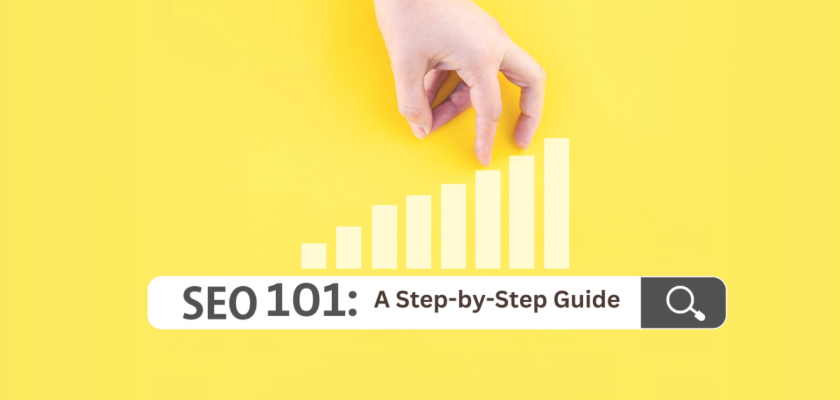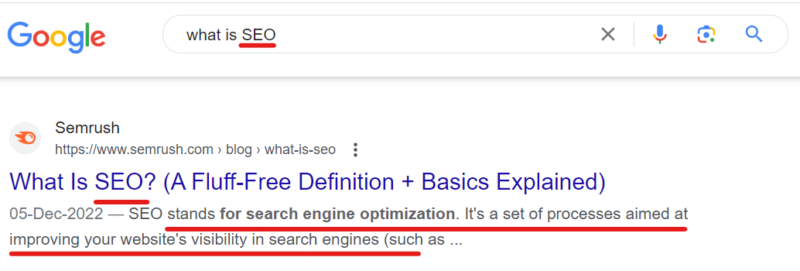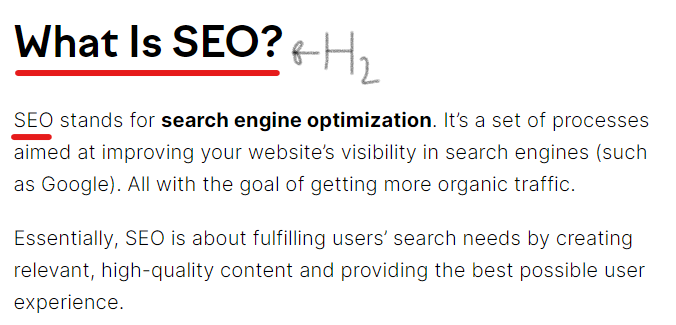Introduction
SEO (Search Engine Optimization) can be challenging for beginners, but this step-by-step tutorial makes it easy for you to optimize your website.
By following this guide, you can ensure that your website is well-optimized, drives traffic, and improves your online presence. With a little effort and patience, you'll be able to see the positive impact of SEO on your website's ranking in search engine results pages.
Before diving into a detailed tutorial, let's briefly discuss what is SEO and why it is important?
What is SEO?
Search engine optimization (SEO) is the process of optimizing a website to rank higher in search engine results pages (SERPs). SEO involves a wide range of techniques and strategies to improve the visibility and relevance of a website to search engines like Google, Bing, and Yahoo.
Why SEO is important for websites?

SEO is essential for websites because it can significantly increase the traffic, leads, and revenue generated from organic searches. When a website is optimized for search engines, it is more likely to appear in relevant search queries, making it easier for potential customers to find and engage with the site.
Let's go through a step-by-step SEO strategy.
Step-by-Step SEO Tutorial
To optimize a website for SEO, there are several steps that need to be followed. These steps include:
- Conducting Keyword Research
- Optimizing Content
- Optimizing On-Page Elements
- Building High-Quality Backlinks
- Monitoring and Analyzing Website Performance
- Implementing Technical SEO Elements
By following these steps, website owners can improve their website's ranking and visibility on search engine results pages.
1-Conduct Keyword Research
Keyword Research
Keyword research is an essential step in SEO optimization. It involves researching and analyzing the keywords that potential customers are using to search for products or services related to your business. By identifying the right keywords, website owners can create content that targets these keywords, making it easier for search engines to understand the relevance of the website to these queries.
Importance of keyword research
Keyword research is crucial to the success of an SEO strategy. It helps website owners understand the search terms and phrases that their potential customers are using to find their products or services. By identifying the right keywords, website owners can create content that targets these keywords, making it easier for search engines to understand the relevance of the website to these queries.
Choosing the right keywords for your website
To choose the right keywords for your website, you need to consider several factors:
– Search Volume and Competition: You want to target keywords that have a high search volume but low competition. This means that there are a lot of people searching for these keywords, but not many websites are targeting them.
– Relevance: You also want to target keywords that are relevant to your business and the products or services you offer. This will ensure that the traffic you receive from these keywords is qualified and more likely to convert into leads or sales.
– Intent: Another important factor to consider is the intent behind the keywords. You want to target keywords that align with the stage of the customer journey that your potential customers are in.
For example, if you are searching for “best coffee shops near me,” what do you expect to see in Google's search results? Probably it is the list of coffee cafes that shows they are likely in the awareness stage of the customer journey.
While if you are searching for “buy coffee beans online” what do you expect to see? After searching in Google search you will see online stores and this phrase shows the result that someone is likely in the consideration or decision stage.
Using keyword research tools
There are several keyword research tools available that can help you identify the right keywords for your website.
Some popular tools include:
– Google Keyword Planner
– Ahrefs
– SEMrush
– Moz Keyword Explorer
These tools provide valuable insights into search volume, competition, and related keywords, making it easier to identify the right keywords for your business.
It is also important to focus on long-tail keywords. Long-tail keywords are more specific and less competitive, making it easier to rank for them. They also tend to have higher conversion rates, as they are more likely to attract qualified traffic.
2-Optimize Your Website's Content
Optimizing your website's content is another crucial step in SEO optimization. High-quality, relevant, and informative content helps improve the user experience on your website and makes it more attractive to search engines.
Importance of high-quality content for SEO
Search engines like Google prioritize high-quality content that provides value to users. High-quality content can increase user engagement, time spent on the site, and reduce bounce rates. These factors are essential for SEO because they signal to search engines that your website is providing valuable and relevant content to users.
Creating content that is optimized for search engines
Creating optimized content requires more than just including keywords. You need to create content that is informative, engaging, and optimized for user experience. This means that your content should be easy to read, with short paragraphs, subheadings, bullet points, and images to break up the text.
To optimize your content for search engines, you need to focus on including keywords in strategic locations, such as the title, meta description, headers, and throughout the body of your content. However, it's important not to overuse keywords, as this can result in keyword stuffing and penalization from search engines.
Incorporating keywords into your content
Incorporating keywords into your content requires careful consideration. You want to ensure that your content includes relevant keywords that match the intent of the user's search query. For example, if someone is searching for “best coffee shops near me,” you want to include keywords like “coffee shops,” “best,” and “near me” in your content.
However, you don't want to force keywords into your content where they don't naturally fit. Instead, focus on creating informative and engaging content that provides value to your audience while incorporating keywords in a natural and strategic way.
3-Optimize Your Website's On-Page Elements
Optimizing your website's on-page elements is another critical step in SEO optimization. On-page elements refer to the elements of a web page that are visible to users, such as title tags, meta descriptions, header tags, and URLs.
On-page Elements That Affect SEO
On-page elements play a crucial role in SEO because they help search engines understand the content on your website. Search engines use these elements to determine the relevance and value of your website's content to user search queries.
How to optimize title tags, meta descriptions, and header tags?
Title tags, meta descriptions, and header tags are some of the most important on-page elements for SEO. Title tags and meta descriptions are displayed in search engine results pages (SERPs), while header tags help structure the content on your web page.
To optimize these elements for SEO, you need to focus on including relevant keywords in the title tag and meta description while keeping them concise and compelling. Header tags should also include relevant keywords while breaking up the content into sections and making it more user-friendly.
How to create user-friendly URLs?
User-friendly URLs are another important on-page element for SEO. A user-friendly URL should be short, descriptive, and easy to remember. It should also include relevant keywords and accurately describe the content of the web page.
To create user-friendly URLs, you should avoid using numbers or special characters and instead use hyphens to separate words. You should also avoid using generic URLs like “page1” or “post123” and instead create URLs that accurately describe the content of the web page.
4-Build High-Quality Backlinks
When it comes to optimizing your website for search engines, backlinks are one of the most important factors to consider.
Backlinks are links from other websites that point to your site, and they play a significant role in determining your website's authority and credibility in the eyes of search engines.
Importance of Backlinks for SEO
Backlinks, also known as inbound links or incoming links, are links from other websites that direct users to your website. Search engines consider backlinks as a vote of confidence from other websites, indicating that your website is trustworthy and valuable. The more high-quality backlinks you have, the higher your website will rank in search engine results pages (SERPs).
Backlinks are one of the most important ranking factors for search engines, and Google has confirmed this on multiple occasions. In fact, backlinks are among the top three ranking factors that Google uses to determine the relevance and authority of a website.
Strategies for Building High-Quality Backlinks
Building high-quality backlinks is not an easy task, but it is crucial for your website's SEO. Here are some strategies that you can use to build high-quality backlinks:
- Create high-quality content: The first and most important step to building backlinks is to create high-quality content that people will want to link to. If your content is valuable, informative, and engaging, other websites will be more likely to link to it.
- Guest posting: Guest posting is a great way to build backlinks while also establishing yourself as an authority in your industry. Find relevant blogs in your niche and offer to write a guest post for them. In return, you can include a link back to your website in your author bio.
- Broken link building: Broken link building involves finding broken links on other websites and offering to replace them with a link to your own content. This strategy requires some research and outreach, but it can be very effective.
- Infographics: Infographics are a great way to present complex information in a visually appealing way. If you create an infographic that is informative and engaging, other websites may link to it.
- Social media: Social media is a great way to promote your content and build backlinks. Share your content on social media platforms and encourage your followers to share it as well.
Tools for Tracking and Monitoring Backlinks
To effectively build and manage your backlink profile, you'll need to use a variety of tools. Here are some of the most popular backlink tracking and monitoring tools:
- Ahrefs: Ahrefs is a powerful SEO tool that includes a backlink tracker. It allows you to monitor your backlink profile and track your progress over time.
- SEMrush: SEMrush is another popular SEO tool that includes a backlink tracker. It provides detailed information on your backlinks, including the domain authority of the linking website.
- Moz: Moz is a comprehensive SEO tool that includes a backlink tracker, as well as other features such as keyword research and on-page optimization.
5-Monitor and Analyze Your Website's Performance
As you implement different strategies to optimize your website for search engines, it's important to monitor and analyze your website's performance to ensure that you're achieving your goals.
Website analytics tools can provide valuable insights into your website's traffic, user behavior, and overall performance. Here are the key aspects to consider when monitoring and analyzing your website's performance:
Importance of Tracking Website Performance
Tracking your website's performance is crucial for several reasons. It allows you to:
– Identify the sources of your website traffic
– Determine which pages and content are the most popular
– Analyze user behavior on your website, such as which pages they spend the most time on or where they drop off
– Measure the success of your SEO strategies and identify areas for improvement
– Make data-driven decisions to optimize your website for better performance
Website Analytics Tools
There are various website analytics tools available, both free and paid, that can help you track and analyze your website's performance. The most popular ones include:
– Google Analytics: A free web analytics tool provided by Google that provides comprehensive insights into website traffic and user behavior.
– SEMrush: A paid SEO tool that offers website analytics, as well as keyword research, site audit, and backlink analysis features.
– Ahrefs: Another paid SEO tool that provides website analytics and other features such as backlink analysis and competitor research.
Key Metrics to Track and Analyze
To effectively monitor and analyze your website's performance, there are several key metrics that you should focus on, including:
– Traffic sources: Identify where your website traffic is coming from, such as search engines, social media, or referrals from other websites.
– Traffic volume: Measure the overall amount of traffic your website is receiving.
– Bounce rate: The percentage of visitors who leave your website after viewing only one page.
– Pages per session: The average number of pages a visitor views during a session.
– Average session duration: The average amount of time visitors spend on your website.
– Conversion rate: The percentage of visitors who complete a desired action, such as making a purchase or filling out a contact form.
By tracking and analyzing these metrics, you can gain valuable insights into your website's performance and identify areas for improvement to better optimize your website for search engines.
6-Technical SEO
Technical SEO involves optimizing the underlying technical structure of your website to improve its search engine rankings.
Technical SEO encompasses a variety of elements, including website speed, mobile responsiveness, website structure, and navigation, and other technical factors that impact search engine rankings.
How to optimize website speed and mobile responsiveness
Website speed and mobile responsiveness are critical factors that affect user experience and search engine rankings. A slow-loading website or one that doesn't perform well on mobile devices can negatively impact your search engine rankings.
To optimize your website speed, start by compressing your images and minimizing the use of plugins or external scripts. Use a content delivery network (CDN) to distribute your site's content across multiple servers, reducing the load time for users. Use a reliable hosting provider with fast server response times.
To optimize your website's mobile responsiveness, use a responsive design that adjusts to different screen sizes and resolutions. Ensure that all content is easily accessible and readable on mobile devices, and optimize your website's images and videos for mobile.
How to optimize website structure and navigation
A well-structured website with clear navigation helps search engine bots crawl and index your site more efficiently, leading to better search engine rankings. Here are some tips for optimizing your website's structure and navigation:
– Use descriptive and keyword-rich URLs
– Create an XML sitemap to help search engine bots crawl your site more efficiently
– Use header tags (H1, H2, H3) to organize your content and make it easier for search engine bots to understand the structure of your site
– Use internal linking to help users and search engine bots navigate your site more easily.
Some Important Tools Used for SEO
Search engine optimization (SEO) is a crucial aspect of online marketing that helps websites rank higher on search engine results pages (SERPs).
To achieve optimal results, various tools are available in the market that helps in optimizing the website's content, backlinks, and technical aspects. Here are some of the top SEO tools:
– RankMath SEO: A popular WordPress plugin that helps optimize website content and on-page elements for higher SERP rankings.
– Smash Balloon: A social media plugin that enables users to embed their social media feeds on their website, thus improving website engagement and increasing traffic.
– SEOPress: A plugin that allows users to optimize their website's on-page elements, including title tags, meta descriptions, and header tags, for better visibility on SERPs.
– HubSpot: A comprehensive marketing tool that includes SEO optimization, content creation, email marketing, and social media management, all in one platform. It provides a holistic approach to SEO optimization and helps businesses improve their online presence.
WordPress SEO Tool
RankMath SEO is a popular plugin for WordPress users looking to improve their website's search engine rankings.
This plugin offers a variety of features, including advanced SEO analysis and optimization, automatic image optimization, and rich snippets support, among others. With its user-friendly interface and detailed documentation, RankMath SEO is an excellent tool for beginners and experienced users alike.
Moreover, the plugin offers a variety of integrations and extensions, making it easy to customize and tailor your SEO strategy to your specific needs. So, RankMath SEO is a reliable and powerful tool for anyone looking to improve their website's visibility and search engine performance.
Read also: How to Rank Blog Posts using Rank Math SEO Plugin
Conclusion
In conclusion, optimizing your website for SEO is essential to improve your website's visibility and attract more organic traffic. By following the step-by-step guide outlined in this article, you can learn the basics of SEO and implement effective optimization strategies for your website.
So, start optimizing your website for SEO today and continue to improve your website's visibility and success in the digital landscape.
Remember, SEO is an ongoing process, and there is always more to learn. To balance informative content with SEO optimization, focus on creating content that provides value to your target audience and incorporates your target keywords naturally.
Finally, keep learning and experimenting with new strategies to continue improving your website's SEO performance.










